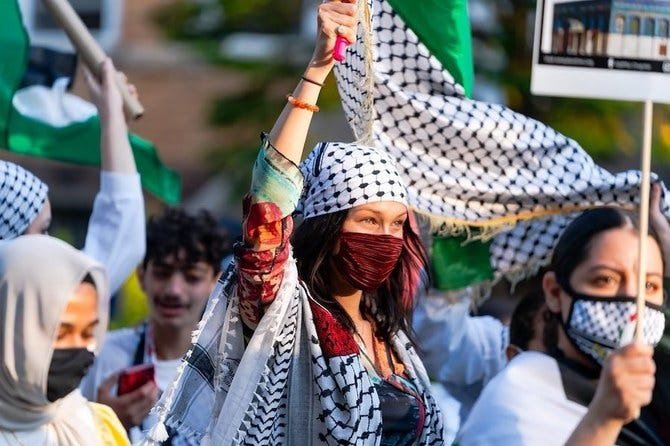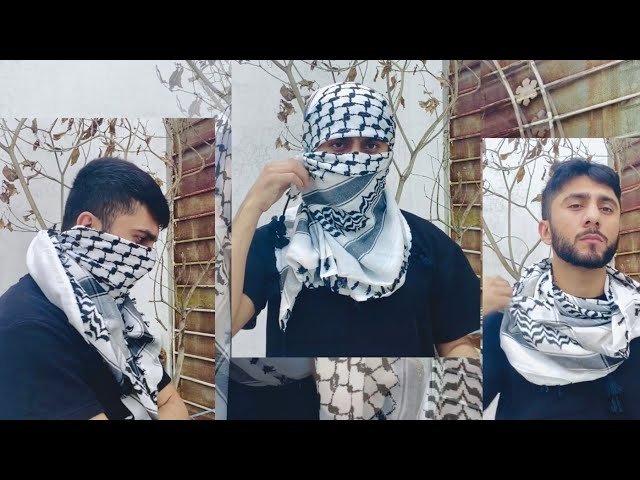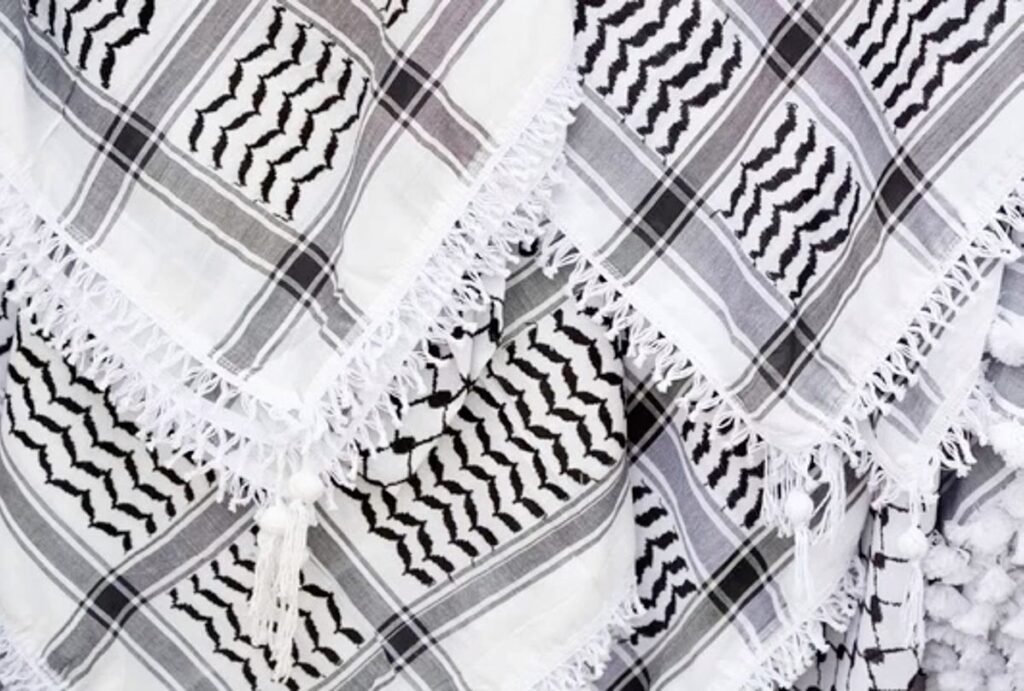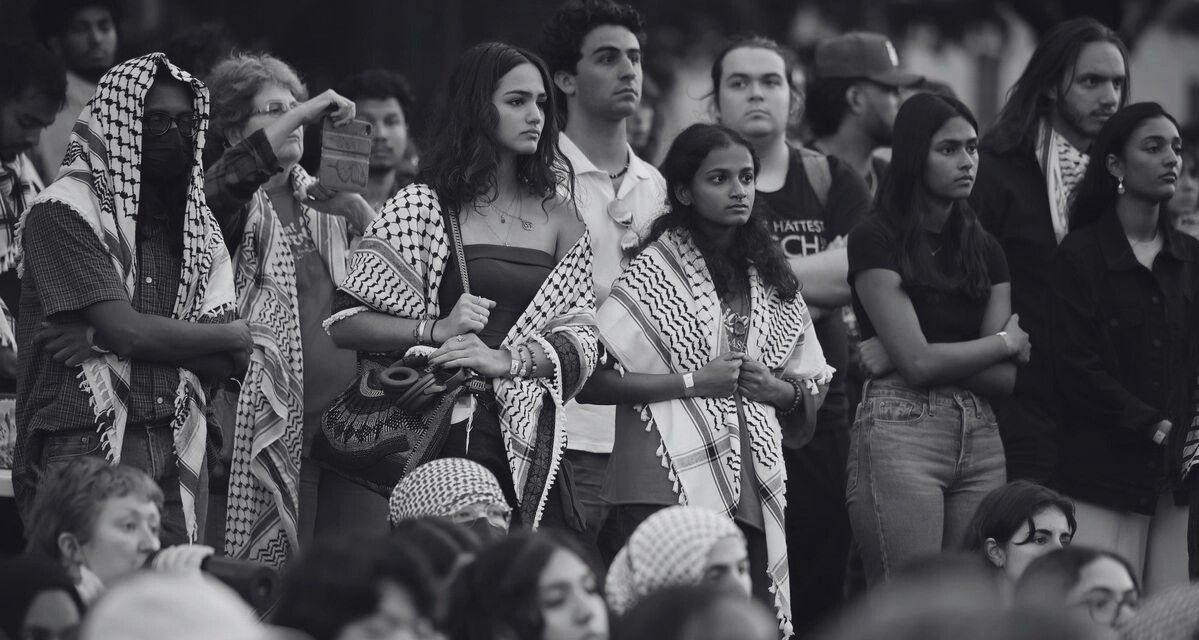Walk through a march, scroll social feeds, or browse a fashion gallery and you will see a familiar check pattern again and again. The keffiyeh is everywhere right now. For some it is a practical scarf. For many it is heritage and pride made visible. This guide explains what a keffiyeh is, where it comes from, and why it has drawn so much attention in recent years.
What is a keffiyeh?
A keffiyeh is a square cotton scarf with a distinctive checked weave. People also call it kufiya or shemagh depending on region. For centuries it served a simple purpose. It kept sun, wind, and dust off the face and neck in dry landscapes. The form is straightforward. Fold the square into a triangle. Wrap and tie for protection or warmth. That utility is why it spread across the Middle East and beyond. Wikipedia
How a practical scarf became a cultural symbol
Over time the scarf carried another meaning. During the late nineteen thirties in Palestine, people from cities and villages began wearing the keffiyeh as an everyday sign of unity during the revolt against British rule. It was no longer only farm wear. It became a visual language of belonging and resistance seen in streets and meeting halls. In the decades that followed, the black and white pattern became closely linked with Palestinian identity. Images of Yasser Arafat in a keffiyeh fixed that association in headlines and archives around the world. The GuardianWikipedia
Fashion, media, and the long arc to global visibility
The scarf moved from field and square to film stills, album covers, and runways. Western celebrities adopted it as a striking accessory. Designers borrowed the pattern for seasonal collections. That blend of culture and fashion brought new admirers and also debate. Some praised the visibility. Others argued the meaning should not be separated from the people who gave the scarf its weight. Either way, the pattern became easy to recognize even for those who did not know its name. Recent explainers trace this journey from protection against sun to a modern emblem that appears in galleries and luxury lines as well as in everyday wardrobes. TIME
Why interest surged recently
The past two years brought a wave of public attention. Large solidarity marches around the world used the keffiyeh as a simple, readable sign. News coverage showed a rise in online searches and purchases in the United States at the end of twenty twenty three. Distributors reported fast sell outs of Palestinian made scarves as more people looked for authentic sources. Annual World Keffiyeh Day, marked each year on eleven May, also helped introduce the scarf to new audiences who shared photos and stories.
Al Jazeera Rajaeen.com handmadepalestine.com
Craft, makers, and authenticity
Behind every scarf is a loom and a workshop. One well known producer is the Hirbawi family in Hebron. The factory began in nineteen sixty one and is often cited as the only place inside Palestine that still weaves keffiyehs at scale. Their story matters because it connects buyers to living craft and to the communities that keep the pattern alive. If you care about origin, look for clear product photos, labels, and sourcing notes. Al Jazeera
What the patterns and colors signal
People often ask what the black and white pattern means. Interpretations vary by source, but the style most recognized today is tied to Palestine and to public life there. Red and white patterns are common across Jordan and the Gulf. You will also see variations in tassels, edge stitching, and density of the weave. These details show the maker’s choices and sometimes the region where a style first took hold. Wikipedia
How people wear it today?
There is no single correct way. Fold to a triangle and drape as a scarf for daily wear. Wrap around the head for sun and wind. Tie once at the front for a loose look or once behind the neck for a closer fit. In colder weather, layer it over a coat. For a dress look, choose a finer weave and let the tassels frame the shoulders. The point is comfort, not strict rules.



Common questions:
Is Keffiyeh only a fashion item?
It can be fashion, but for many it carries history and family memory. Recent opinion and culture pieces describe it as a visible link to identity in public spaces. The Guardian
Is it ok to wear if I am not from the region?
People have different views. A thoughtful approach helps. Learn why it matters to others. Buy from makers who state origin clearly. Wear it with respect and be open to conversation.
How do I choose an authentic piece?
Look for details. Clear photos of the weave. Labels and origin. Notes about the mill. If the brand cites a known factory, read about it and compare patterns and finishing. Al Jazeera
How do I care for it?
Hand wash or gentle machine cycle in cold water. Air dry to keep the drape and the tassels neat. Store folded so the edges do not stretch.
Why this simple cloth still speaks?
The keffiyeh lasts because it does two jobs at once. It’s useful. Keeps you warm, cool, or covered depending on the season. And It also tells a story. In times of crisis or celebration, a scarf can carry meaning across borders without a single word. That is why you will see it in crowds, on stages, and in studios. The pattern is easy to spot. The feelings behind it are complex and human.
Where to learn more about the Keffiyeh?
If you want to read deeper histories, start with an overview of the garment and its regional names. Then read accounts that follow how it became linked with Palestinian identity and how demand has shifted in recent years.
- Overview and history of the scarf and its uses. Wikipedia
- How the scarf became a global symbol and when that shift began. The Guardian
- Recent demand and search interest reported by major outlets. Al Jazeera
- A look inside a Palestinian factory that still weaves the pattern. Al Jazeera
- Reflections on identity and public life from a recent opinion piece. The Guardian
